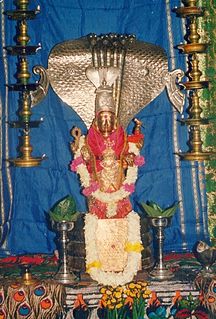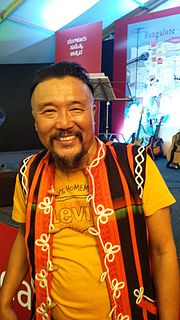External links
Mahallaka Naga of Anuradhapura | ||
| Regnal titles | ||
|---|---|---|
| Preceded by | King of Anuradhapura 135–141 | Succeeded by |
| Mahallaka Naga | |
|---|---|
| King of Anuradhapura | |
| Reign | 135–141 |
| Predecessor | Gajabahu I |
| Successor | Bhatika Tissa |
| Issue | Bhatika Tissa Kanittha Tissa |
| Dynasty | Lambakanna dynasty |
Mahallaka Naga was the King of Anuradhapura from the House of Lambakanna I. He ruled from 135 till 141 AD. He was preceded by his father in law, Gajabahu I and succeeded by his son, Bhatika Tissa. During his succession to the throne, the king was very old, and thus he was popularly known as Mahallaka Naga or Mahalu Naga.

The Nāga or Nāgī is a divine or semi-divine race of half-human half-serpent beings that reside in the netherworld (Patala) and can occasionally take human form. Rituals devoted to these supernatural beings have been taking place throughout south Asia for at least two thousand years, and thought to have been originally inspired by dragons from Chinese myth. They are principally depicted in three forms: wholly human with snakes on the heads and necks, common serpents, or as half-human half-snake beings in Hinduism, Buddhism and Jainism.

Vāsuki is the second king of serpents in Hindu and Buddhist religion. He is described as having a gem called Nagamani on his head. Manasa, another naga, is his sister. Vāsuki is Shiva's snake. He is known in Chinese and Japanese mythology as being one of the "eight Great Dragon Kings", amongst Nanda (Nāgarāja), Upananda, Sāgara (Shakara), Takshaka, Balavan, Anavatapta and Utpala.

Naga Panchami is a day of traditional worship of Nagas or snakes observed by Hindus, Jains, and Buddhists throughout India, Nepal, and other countries where Hindu, Jain, and Buddhist adherents live. The worship is offered on the fifth day of bright half of lunar month of Shravana (July/August), according to the Hindu calendar. Some Indian states, such as Karnataka, Rajasthan and Gujarat, celebrate Naga Panchami on the dark half of the same month. As part of the festivities, a Naga or serpent deity made of silver, stone, wood, or a painting of snakes is given a reverential bath with milk and their blessings are sought for the welfare of the family. Live snakes, especially cobras, are also worshipped on this day, especially with offerings of milk and generally with the assistance of a snake charmer.

Japanese dragons are diverse legendary creatures in Japanese mythology and folklore. Japanese dragon myths amalgamate native legends with imported stories about dragons from China, Korea and the Indian subcontinent. The style of the dragon was heavily influenced by the Chinese dragon. Like these other East Asian dragons, most Japanese ones are water deities associated with rainfall and bodies of water, and are typically depicted as large, wingless, serpentine creatures with clawed feet. The modern Japanese language has numerous "dragon" words, including indigenous tatsu from Old Japanese ta-tu, Sino-Japanese ryū or ryō竜 from Chinese lóng龍, nāga ナーガ from Sanskrit nāga, and doragon ドラゴン from English "dragon".

Nāgarāja are the serpent-like figures that appear in Hindu and Buddhist mythology. These are the kings of the various races of serpents.
Janamejaya was a Kuru king who reigned during the Middle Vedic period. Along with his father and predecessor Parikshit, he played a decisive role in the consolidation of the Kuru state, the arrangement of Vedic hymns into collections, and the development of the orthodox srauta ritual, transforming the Kuru realm into the dominant political and cultural part of northern India. He also appears as a figure in later legends and traditions, the Mahabharata and the Puranas.
Gajabahu I, also known as Gajabahuka Gamani, was a Sinhalese king of Rajarata in Sri Lanka. He is renowned for his military prowess, religious benefactions, extensive involvement in south Indian politics, and for possibly introducing the cult of the goddess Pattini to Sri Lanka. The primary source for his reign is the Mahavamsa, though he is also the only early Sri Lankan king to be extensively mentioned in the Chera Cilappatikaram.

Takshak is a Nagaraja in Hinduism and Buddhism. He is mentioned in the Hindu epic Hindu Mythology. He was king of Nagas. He was one of the sons of Kadru.

The Naga people were believed to be an ancient tribe who once inhabited Sri Lanka and various parts of Southern India. There are references to them in several ancient texts such as Mahavamsa, Manimekalai and also in other Sanskrit and Pali literature. They are generally being represented as a class of superhumans taking the form of serpents who inhabit a subterranean world.

Rewben Mashangva, also Guru Rewben Mashangva, is a folk musician and singer from Manipur, India. He is known for reviving musical tradition of the Tangkhul Naga of Manipur, and use of traditional musical instruments in his songs. Influenced by musicians such as Bob Dylan and Bob Marley, Rewben Mashangva has created many Naga tribal folk songs based on blues and ballad rhythms. He is known by different names including, 'Bob Dylan of the Nagas' and 'King of Naga folk blues', plus 'Father of Naga folk blues'. He received the National Tribal Award 2011-12, for his contribution to the development of tribal music from the Ministry of Tribal Affairs, Government of India. The Government of India honoured him in 2021, with the award of Padma Shri, the fourth highest Indian civilian award for his rich contribution to art.

The Bharshiva dynasty was the most powerful dynasty of the pre-Gupta period. The Nagas of Vidisha moved to Mathura and start annexing other kingdoms under Virasena. They made Padmavati Pawaya, Kantipuri and Vidisha their capitals and placed their family members as rulers of the states. They ruled parts of north-central India during the 3rd and the 4th centuries, after the decline of the Kushan Empire and before the rise of the Gupta Empire. Its capital was located at Padmavati, which is identified with modern Pawaya in Madhya Pradesh. Modern historians identify it with the family that is called Bharashiva in the records of the Vakataka dynasty.
Chora Naga, also known as Coranaga or Mahanaga, was King of Anuradhapura in the 1st century BC, who ruled from 62 BC to 50 BC. He succeeded his cousin Mahakuli Mahatissa as King of Anuradhapura and was succeeded by Kuda Tissa. King Chora Naga was not a follower of the Mahavihara sect. He had even demolished 18 temples that belong to Mahavira. As a result, the author of the Mahāvaṃsa referred to him as a thief.
Bhatika Tissa was King of Anuradhapura in the 2nd century, whose reign lasted from 141 to 165. He succeeded his father Mahallaka Naga as King of Anuradhapura and was succeeded by his brother Kanittha Tissa.
Kuda Naga was King of Anuradhapura in the 2nd century, whose reign lasted from 195 to 196. He succeeded his brother Cula Naga as King of Anuradhapura and was assassinated and succeeded by his brother-in-law, Siri Naga I.
Siri Naga I was King of Anuradhapura in the 2nd century, whose reign lasted from 196 to 215. He succeeded his brother-in-law Kuda Naga as King of Anuradhapura and was succeeded by his son Voharika Tissa.
Voharika Tissa was King of Anuradhapura in the 3rd century, whose reign lasted from 215 to 237. He succeeded his father Siri Naga I as King of Anuradhapura and was succeeded by his brother Abhaya Naga.
Vijaya Kumara was King of Anuradhapura in the 3rd century, whose reign lasted from 247 to 248. He succeeded his father Siri Naga II as King of Anuradhapura and was succeeded by Sangha Tissa I.
Aggabodhi I was King of Anuradhapura in the 6th century, whose reign lasted from 564 to 598. He succeeded his cousin Maha Naga as King of Anuradhapura and was succeeded by his nephew Aggabodhi II.
Haipou Jadonang (1905-1931) was a Naga spiritual leader and political activist from Manipur, British India. He established the Heraka religious movement, which was based on the ancestral Naga religion, and declared himself to be the "messiah king" of the Nagas. His movement was widespread in the Zeliangrong territory before the conversion to Christianity. He also espoused the cause of an independent Naga kingdom, which brought him in conflict with the colonial British rulers of India. He was hanged by the British in 1931, and succeeded by his cousin Rani Gaidinliu.